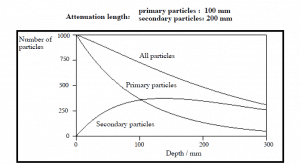X-rays, also known as X-radiation, refer to electromagnetic radiation (no rest mass, no charge) of high energies. X-rays are high-energy photons with short wavelengths and thus very high frequency. The radiation frequency is the key parameter of all photons because it determines the energy of a photon. Photons are categorized according to their energies, from low-energy radio waves and infrared radiation, through visible light, to high-energy X-rays and gamma rays.
Most X-rays have a wavelength ranging from 0.01 to 10 nanometers (3×1016 Hz to 3×1019 Hz), corresponding to energies in the range of 100 eV to 100 keV. X-ray wavelengths are shorter than those of UV rays and typically longer than those of gamma rays. The distinction between X-rays and gamma rays is not so simple and has changed in recent decades. According to the currently valid definition, X-rays are emitted by electrons outside the nucleus, while gamma rays are emitted by the nucleus.
X-ray Attenuation
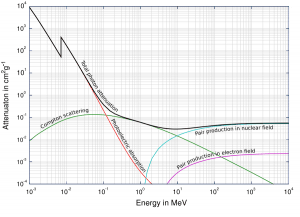
Source: Wikimedia Commons
As the high-energy photons pass through a material, their energy decreases, which is known as attenuation. The attenuation theory is valid for X-rays and gamma rays as well. It turns out that higher energy photons (hard X-rays) travel through tissue more easily than low-energy photons (i.e., the higher energy photons are less likely to interact with matter). Much of this effect is related to the photoelectric effect. The probability of photoelectric absorption is approximately proportional to (Z/E)3, where Z is the atomic number of the tissue atom and E is the photon energy. As E gets larger, the likelihood of interaction drops rapidly. For higher energies, Compton scattering becomes dominant. Compton scattering is about constant for different energies, although it slowly decreases at higher energies.
Exponential Attenuation
Assuming that monoenergetic X-rays are collimated into a narrow beam, the detector behind the material only detects the X-rays that passed through that material without any kind of interaction with this material. Then the dependence should be simple exponential attenuation of X-rays. Each of these interactions removes the photon from the beam either by absorption or scattering away from the detector direction. Therefore the interactions can be characterized by a fixed probability of occurrence per unit path length in the absorber. The sum of these probabilities is called the linear attenuation coefficient:
μ = τ(photoelectric) + σ(Compton)
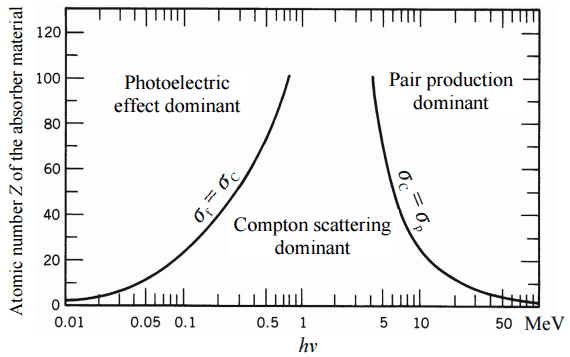
Linear Attenuation Coefficient – X-rays
The attenuation of X-rays can then be described by the following equation.
I=I0.e-μx
where I is intensity after attenuation, Io is incident intensity, μ is the linear attenuation coefficient (cm-1), and the physical thickness of absorber (cm).
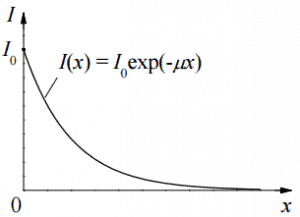
The materials listed in the table are air, water, and different elements from carbon (Z=6) through to lead (Z=82), and their linear attenuation coefficients are given for two X-ray energies. There are two main features of the linear attenuation coefficient:
- The linear attenuation coefficient increases as the atomic number of the absorber increases.
- The linear attenuation coefficient for all materials decreases with the energy of the X-rays.
Half Value Layer
The half-value layer expresses the thickness of absorbing material needed to reduce the incident radiation intensity by a factor of two. There are two main features of the half-value layer:
- The half-value layer decreases as the atomic number of the absorber increases. For example, 35 m of air is needed to reduce the intensity of a 100 keV X-ray beam by a factor of two, whereas just 0.12 mm of lead can do the same.
- The half-value layer for all materials increases with the energy of the X-rays. For example, from 0.26 cm for iron at 100 keV to about 0.64 cm at 200 keV.
Mass Attenuation Coefficient
We can sometimes use the mass attenuation coefficient when characterizing an absorbing material. The mass attenuation coefficient is defined as the ratio of the linear attenuation coefficient and absorber density (μ/ρ). The attenuation of X-rays can be then described by the following equation:
I=I0.e-(μ/ρ).ρl
, where ρ is the material density, (μ/ρ) is the mass attenuation coefficient, and ρ.l is the mass thickness. The measurement unit was used for the mass attenuation coefficient cm2g-1. For intermediate energies, the Compton scattering dominates, and different absorbers have approximately equal mass attenuation coefficients. This is due to the fact that the cross-section of Compton scattering is proportional to the Z (atomic number). Therefore the coefficient is proportional to the material density ρ. At small values of X-ray energy, where the coefficient is proportional to higher powers of the atomic number Z (for photoelectric effect σf ~ Z3), the attenuation coefficient μ is not a constant.
See also calculator: Gamma activity to dose rate (with/without shield)
See also XCOM – photon cross-section DB: XCOM: Photon Cross Sections Database
Example:
How much water shielding do you require if you want to reduce the intensity of a 100 keV monoenergetic X-ray beam (narrow beam) to 1% of its incident intensity? The half-value layer for 100 keV X-rays in water is 4.15 cm, and the linear attenuation coefficient for 100 keV X-rays in water is 0.167 cm-1. The problem is quite simple and can be described by the following equation:
 If the half-value layer for water is 4.15 cm, the linear attenuation coefficient is:
If the half-value layer for water is 4.15 cm, the linear attenuation coefficient is: Now, we can use the exponential attenuation equation:
Now, we can use the exponential attenuation equation: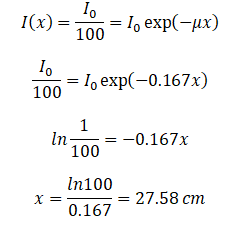
So the required thickness of water is about 27.58 cm. This is a relatively large thickness, and it is caused by small atomic numbers of hydrogen and oxygen. If we calculate the same problem for lead (Pb), we obtain the thickness x=0.077 cm.
Linear Attenuation Coefficients
Table of Linear Attenuation Coefficients (in cm-1) for different materials at photon energies of 100, 200, and 500 keV.
| Absorber | 100 keV | 200 keV | 500 keV |
| Air | 0.0195/m | 0.0159/m | 0.0112/m |
| Water | 0.167/cm | 0.136/cm | 0.097/cm |
| Carbon | 0.335/cm | 0.274/cm | 0.196/cm |
| Aluminium | 0.435/cm | 0.324/cm | 0.227/cm |
| Iron | 2.72/cm | 1.09/cm | 0.655/cm |
| Copper | 3.8/cm | 1.309/cm | 0.73/cm |
| Lead | 59.7/cm | 10.15/cm | 1.64/cm |
Half Value Layers
Table of Half Value Layers (in cm) for different materials at photon energies of 100, 200, and 500 keV.
| Absorber | 100 keV | 200 keV | 500 keV |
| Air | 3555 cm | 4359 cm | 6189 cm |
| Water | 4.15 cm | 5.1 cm | 7.15 cm |
| Carbon | 2.07 cm | 2.53 cm | 3.54 cm |
| Aluminium | 1.59 cm | 2.14 cm | 3.05 cm |
| Iron | 0.26 cm | 0.64 cm | 1.06 cm |
| Copper | 0.18 cm | 0.53 cm | 0.95 cm |
| Lead | 0.012 cm | 0.068 cm | 0.42 cm |
Validity of Exponential Law
The exponential law will always describe the attenuation of the primary radiation by matter. If secondary particles are produced, or the primary radiation changes its energy or direction, the effective attenuation will be much less. The radiation will penetrate more deeply into matter than is predicted by the exponential law alone. The process must be considered when evaluating the effect of radiation shielding.
